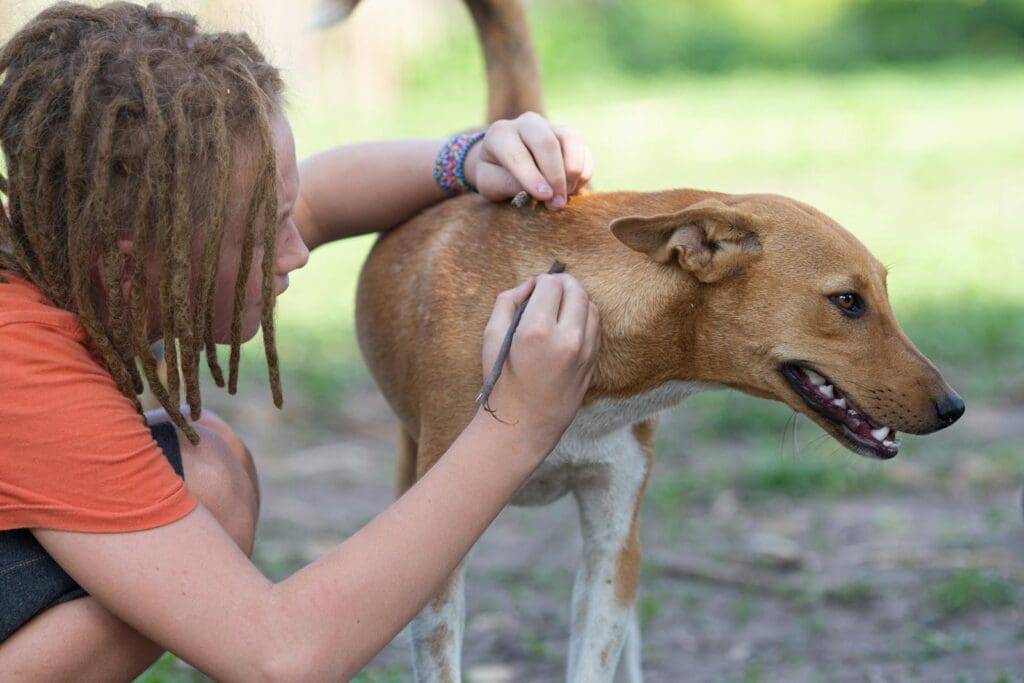Microchipping is a permanent way of identifying your pet and increases your odds of finding them if lost. Here’s everything you need to know about how to chip your pet — the cost, procedure, registration, scanning, tracking, and more.
What Is Pet Microchipping?

Pet microchipping is the process of inserting a tiny microchip under an animal’s skin. Each microchip contains a unique identification number that is linked to the contact information of the owner in an online database.
The microchip is safe and should last the lifetime of the pet. Microchips can be applied to many different animals, including dogs, cats, ferrets, horses, and most other mammals. They never need to be charged and there are no batteries. These chips rarely need to be replaced.
What Does the Chipping Procedure Involve?

A large-bore needle is used to insert a small chip under the skin of the animal. It’s about the size of a grain of rice. It is actually a tiny computer chip that is housed in a special type of glass that is compatible with living tissue.
No anesthesia is required. Although the needle is larger than a typical vaccination needle, in most cases, the experience for the dog is about the same. Dogs typically experience little to no pain from the implantation, and barely notice it.
Microchips are typically placed between the shoulder blades. They should remain in place for the life of the animal. The chips are safe and should never need replacing during the lifetime of the animal.
How Much Does Chipping Cost?

You may be able to microchip your dog for free. If not, many places offer low-cost microchipping. The average cost currently ranges between $25-$60.
How to Get Your Dog Microchipped

Many dogs that come from shelters or rescue organizations are microchipped before being released for adoption. However, if your dog is not microchipped, here is how you can go about getting the procedure done.
There are a variety of places that offer pet microchipping. Here are a few of the most common places:
- A veterinarian’s office: Check with your local vet.
- Animal shelters: Many offer free or low-cost free services.
- Humane Society: Offers micro-chipping for a low fee at their vaccination clinics.
- The Animal Foundation: Offers low-cost pet chipping by appointment.
3 Things to do After Your Pet Is Chipped

Make sure to do the following after having your pet microchipped:
- Register your pet and the chip with a pet database.
- During your annual veterinary visit, ask your vet to scan your pet’s microchip to make sure it can be detected and is still functioning.
- Keep your registration information up-to-date.
What Do They Do and What They Are Not

In essence, a pet microchip is something that can be scanned if your dog gets lost and winds up at a shelter, veterinarian’s office, or veterinary hospital. A staff member will use a chip reader to scan to see if the pet has one in order to retrieve the owner’s contact information.
However, a microchip is not a GPS locator. A lost microchipped pet cannot be tracked.
How They Connect Lost Pets With Their Owners

If you ever lose your pet, the chip can be scanned to reveal the owner’s contact information, which is stored in a national database. There are a variety of databases in the US, including PetLink, Pet Chip Registry, PETMAXX, and Free Pet Microchip Registry.
Other useful resources: AAHA, which provides a registry lookup. This registry lookup tool doesn’t provide pet owner information but rather helps owners find the registry where their pet’s chip is listed.
Potential Problems

Although microchips are safe and designed to last for the life of your pet, there are some potential problems.
Potential Issue: Old Chips

Depending on the brand, and the year it was implanted, some scanners — even “universal” ones — cannot detect older chips. Most new chips are compatible with universal scanners.
Potential Issue: Chip Migration

In most cases, the chip never moves from where it was implanted throughout the pet’s lifetime. However, there are known instances of chips migrating from where it was originally implanted. If the chip cannot be detected, then be sure to scan the dog’s entire body, including the limbs.






